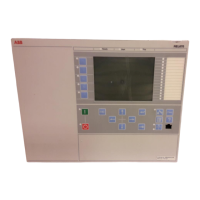HMI Signal Name: Status Description
RTC READY / FAIL This signal will be active when there is a
hardware error with the real time clock.
Time Sync READY / FAIL This signal will be active when the
source of the time synchronization is
lost, or when the time system has to
make a time reset.
Application
READY / FAIL This signal will be active if one or more
of the application threads are not in the
state that Runtime Engine expects. The
states can be CREATED, INITIALIZED,
RUNNING, etc.
RTE
READY / FAIL This signal will be active if the Runtime
Engine failed to do some actions with the
application threads. The actions can be
loading of settings or parameters for
components, changing of setting groups,
loading or unloading of application
threads.
IEC61850
READY / FAIL This signal will be active if the IEC 61850
stack did not succeed in some actions
like reading IEC 61850 configuration,
startup etc.
LMD
READY / FAIL LON network interface, MIP/DPS, is in
an unrecoverable error state.
LDCMxxx READY / FAIL Line Differential Communication Error
status
OEM READY / FAIL Optical Ethernet Module error status
Also the internal signals, such as INT--FAIL and INT--WARNING can be
connected to binary output contacts for signalling to a control room.
In the IED Status - Information, the present information from the self-supervision
function can be viewed. Indications of failure or warnings for each hardware
module are provided, as well as information about the external time
synchronization and the internal clock. All according to table
31. Loss of time
synchronization can be considered as a warning only. The IED has full
functionality without time synchronization.
When settings are changed in the IED, the protection and control applications
restart in order to take effect of the changes. During restart, internal events get
generated and Runtime App error will be displayed. These events are only
indications and will be for short duration during the restart.
IED will not be operational during applications restart.
1MRK 506 377-UEN C Section 12
Troubleshooting
Railway application RER670 2.2 IEC 191
Commissioning manual

